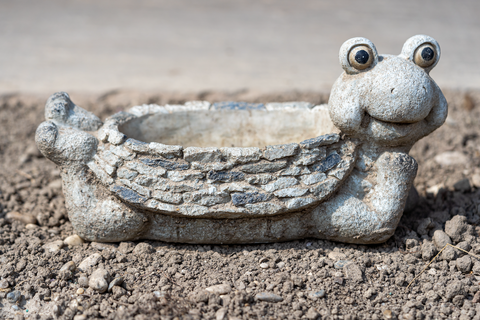A Guide On How To Paint Your Concrete Garden Statue
Aug 16,2022 | yoflos.com
How to prep concrete statues for painting
When preparing to paint a concrete sculpture, you can't simply begin painting. There is important work that happens before you can start adding color and character to your statue. In these "prep steps," you'll have the chance to select a statue, clean it thoroughly, and then paint it with a base coat.
This will lay the foundation for a genuinely gorgeous finished product, so don't skimp on this process!
Step 1: Pick a statue
First, you'll need to select the concrete statue you wish to paint. While you can definitely fix up one that's in less-than-stellar condition, this process will be more straightforward if you select a statue that doesn't have any significant cracks, breaks, or other vulnerabilities.
Generally, you can paint just about all outdoor statues, especially if they're made from concrete or stone. This article will focus on painting concrete garden ornaments and statues, but many of the same principles do apply to painting stone.
Step 2: Start by cleaning the statue
Next, you'll need to clean the statue thoroughly. There are a few ways to do this, so read through the following options and determine what method works best for you.
Give that statue a bath
Start by placing your concrete statue in a tub of water, then scrub at it thoroughly with a brush. Whatever you do, don't use soap--that could damage the concrete and make it harder for your paint to adhere.
There's no need to soak the statue overnight or anything like that. It doesn't have to be perfect. But a clean surface will improve the look and feel of your painted statue.
After your statue's bath, you may notice there's still some residue leftover in any unusual folds or tight areas. For any tough-to-reach areas or smaller nooks and crannies, use a toothbrush to get the job done!
Remove debris with a soft-bristled brush
Not feeling up for giving a concrete statue a bubble bath? Fair enough!
If you find any debris on your outdoor concrete statue, you can always use a small, soft-bristled brush to get rid of it. Whatever you do, avoid a stiff brush for this process, as it can damage the statue. A softer brush will allow you to remove cobwebs and dirt quickly without causing any distress to your piece.
Note that this method doesn't call for any water, so it's best for pieces that really aren't so dirty.
Spray it down with a garden hose
Think that statue might prefer a shower to a bath? Go for it!
Try spraying down your statue with a regular garden hose. Just ensure you use clean water, and are gentle with stone. And whatever you do, never use a pressure washer--this could damage the concrete.
As far as soaps go, the same rule applies: don't use anything harsh, and if you are going to use a soap, make sure it meets the criteria covered in the next section.
Use a household cleaner that's totally safe
If your concrete statue is genuinely filthy, you may need to use real cleaning supplies. But put down the Windex and bleach! You'll want to stick with an all-natural, non-abrasive cleaner that won't threaten your piece's integrity.
We recommend using an organic household cleaner and a wet cloth to clean the statue. This is often the best method for removing a green stain, like one from exposure to grass or mold.
Before you begin, test the cleaner on the bottom of your statue, where any damage won't be visible. Observe the sample area immediately and then about 24 hours later to ensure that the cleaning product you've selected won't damage your statue.
Avoid cleaning during cold weather
We know that winter can get long and boring. And we agree: those cold months are the perfect time to do DIY crafts! But, whatever you do, don't clean your concrete outside statue during winter.
Why not? Well, concrete is porous and absorbs moisture. So, when the temperature dips below freezing, any residual water will freeze and expand. This could cause cracks in your sculpture that render it unsuitable for painting and perhaps unfit to display at all!
While you could move this project indoors during the dead of winter, it's probably easier to wait until spring, when you can clean and paint your concrete statues without worrying about ventilation, freezing temperatures, and more.

Step 3: Apply a base coat
However you decide to clean your statue, you'll need to apply a base coat next.
Your first coat of paint should be a solid color, usually white. (Although no rule says you can't choose a dark color!) The paint you select should be an acrylic base coat or mixed with one. Why? This acrylic base coat will help create a smooth, paint-ready surface, so when you do add color, it'll go on smooth.
While it can be tempting to buy cheap paint, you need very little to achieve this project. It's worth the extra couple bucks to invest in good paint that won't chip or fade. Plus, if you have some leftovers from a past interior décor project, you might be able to repurpose it for this project!
How to paint concrete statues
You've selected your concrete statue, cleaned it thoroughly, and applied a high-quality base coat to your piece. Now, it's time to get creative and transform that plain statue into something truly unique.
Let's walk you through exactly how to do it.
Step 1: Select materials carefully
Because you are painting an outdoor statue that will be exposed to the elements, you should select all your materials carefully. When sourcing supplies, pick items that are high quality and intended for outdoor use. You'll also want to keep enough of the product on hand to do touchups from time to time, especially if you live in a climate where conditions are harsh.
Fortunately, everything you'll need to paint and protect your cement statue is commonly found in local craft, art supply, or paint stores!
Step 2: Decide on a type of paint
When choosing paint, you have a few options:
- latex concrete paint
- exterior latex paint
- acrylic paint
- exterior paint
- regular paint
Helpful employees at craft stores and paint shops can help you pick the right paint for your concrete statue and the weather conditions in your city. Here at Happy Gardens, we prefer water-based acrylic latex paint. It's easy to use, holds up well, and is bright and beautiful.
Whatever you do, avoid oil-based paint. It's sure to dry out and crack over time!
The same goes for spray paint. While a nice shortcut, spray paints will never paint concrete perfectly. It simply won't look as nice, and paint applied with a brush lasts longer. If you do insist on using spray paint, you can improve the outcome by painting a base coat and using a topcoat. But again, we really don't recommend it!
Step 3: Pick some paint colors
There are no rules for selecting paint colors, so choose shades and hues that appeal to you! At Happy Gardens, we love:
- Realistic colors for animals
- Rock-like colors for a more natural vibe
- Dark colors for unexpected statements
- Bright colors for a pop of playful charm
Not sure how to paint your statue? You can check out Pinterest for inspiration or just walk around your block. See how other homeowners are decorating their space, or get inspired by the colors you find in nature!
Step 4: Play around with painting methods
There's no rule that says you have to paint concrete statues one solid color or with a perfect coat of paint, either.
Try dry brushing a top coat
To finish your statue, you could try a dry brush method for the topcoat. To do this, dip a new, 2-inch brush in paint, then wipe off most of the excess moisture. Now that the brush is almost dry, wipe the color onto the statues with back-and-forth brushstrokes.
You'll end up with a texturized, "fluffy" result that can bring outdoor concrete statues, especially those of animals, to life!



